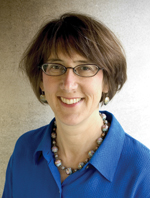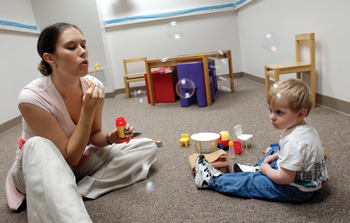
Wendy Stone, Ph.D.
Autism’s impact may extend to younger siblings

Tristan Humber and his family took part in the study of younger siblings of children with autism spectrum disorders. In this photo from from the early stages of the study, Tristan, then age 2, plays with clinical psychology graduate student Caitlin McMahon. (photo by Dana Johnson)
Vanderbilt Kennedy Center researchers are reporting that younger siblings of children with autism spectrum disorders do not perform as well on tests of social and communication development as compared with siblings of children without developmental problems.
These differences are evident at an average age of 16 months, which is below the age at which the diagnosis is typically made.
Wendy Stone, Ph.D., and colleagues Paul Yoder, Ph.D., and Tedra Walden, Ph.D., studied 64 younger siblings of children with autism spectrum disorders (ASD) and 42 younger siblings of children with typical development. Their findings appear in the April issue of Archives of Pediatrics & Adolescent Medicine, a theme issue on ASD.
“Young children who have older siblings with ASD, as a group, show weaker performance in several areas of development as compared to young children whose older siblings are developing typically,” said Stone, who serves as director of VKC's Treatment and Research Institute for Autism Spectrum Disorders (TRIAD).
Differences in cognitive, language and social-communication skills were found on both parental report and observational measures, and may represent early-emerging features of ASD or the "broader phenotype," Stone said.
Studies of twins and families have indicated that autism and related disorders have a genetic basis, according to background information in the article, and an estimated 6 percent to 9 percent of younger siblings of children with ASD will also develop the disorder.
“Continued follow-up of these children is needed so we can determine what impact these early differences have on later development,” Stone said.
“These results highlight the importance of monitoring the development of younger siblings of children with ASD from an early age, so that they can receive early intervention, if needed, to enhance their social and communicative development.”
This five-year study, which is still ongoing, measured siblings 12-23 months using a variety of assessments. Interactive tests assessed thinking, play, imitation and communication skills as well as autism symptoms.
Parents were interviewed and responded to questionnaires regarding their child's social, communication and language skills.
“Younger siblings of children with autism spectrum disorders demonstrated weaker performance in non-verbal problem-solving, directing attention, understanding words and phrases, using gestures, and interacting with parents, and also had increased autism symptoms, relative to control siblings,” Stone said.
The research could assist in developing tailored intervention and prevention strategies for promoting optimal outcomes in this group of at-risk children, she added.
The study was supported by a grant from the National Institute of Child Health and Human Development, as well as by a Mentor-Based Postdoctoral Fellowship from the National Alliance for Autism Research and by the Vanderbilt University Kennedy Center Marino Autism Research Institute (MARI).













